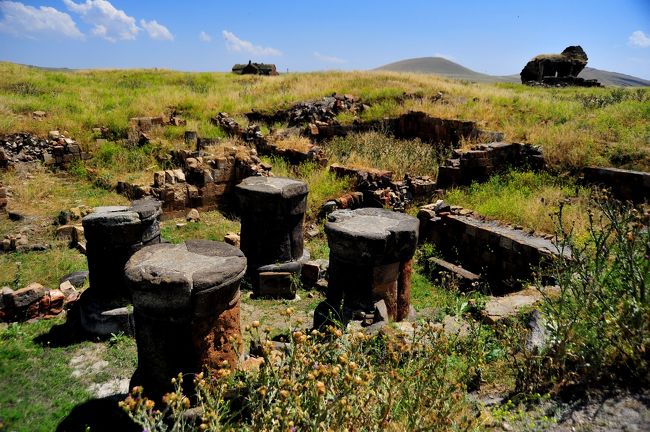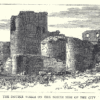[アルメニア] 廃墟都市アニ : “千と一の教会がある都”
アルメニアはイスラエルと並び、祖国の人口より国外居住人口の方が多いディアスポラ(diaspora)の国だ。それだけ地政学的に大国間の思惑が入り乱れる要衝の土地なのだろう。アニはディアスポラが本格化する直前に咲き誇った宗教・交易都市である。
アルメニアについて
アルメニアは世界で初めてキリスト教(といってもローマカトリックとは訣別した東方教会)を国教にした国だ。地政学的に交通の要衝に当たるため、様々な民族が行き交い、支配者はコロコロ変わった(古代アルメニア帝国、ペルシャ帝国、ローマ帝国、イスラム王朝、オスマン帝国など)。

参考:アルメニアの歴史
アニは中世に栄えた。いまは街全体が無人になった廃墟都市だが、荒地に散在する建築群は風格があり美しい。アニで確立されあ建築様式が後のゴシック建築のベースになったという話もきく。いまはトルコ領となり、ろくに遺跡調査も進んでいないらしいが、世界遺跡に認定されるだけの価値があるのである。

バグラトゥニ朝の古都アニ
今回は以下の記事をネタ元にする。
The history of Armenia counts up to twelve capitals. The existence of so many seats of government attests to the instability of the Armenian state, and to a number of invasions and conquerors. But it is also a sign, each time, of renewed efforts to establish kingdoms, principalities, and, finally, republics.
「有史上アルメニアの首都は12を数える。たびたび侵略や征服に晒されたアルメニア国家の不安定を物語る。しかし遷都のたびに王国へ、公国へ、共和国として体制の建て直しが図られた証拠でもある。」
principality(princedom)とは
公国と訳される。政体にはkingdom(王国)、monarchy(君主国)、republic(共和国)など様々な種類がある。大きな違いはrepublicの場合、その国は公式に国民の持ち物だが、他は国家元首の持ち物である点だ。国民の持ち物といいつつ北朝鮮人民主義「共和国」のような例もあるので共和国が独裁国家である場合も珍しくない(かつてのソ連も共和国だった)。
principalityは、kingdomのkingの子息が王国の一部領地を統治する場合が多かった。しかし王と血縁関係がなくても王に次ぐ位を持つ者(ローマ法王に王と認められていない貴族など)が支配した場合もある。princeは必ずしも王の息子に限定されないのである。
ちなみに日本は公式には立憲君主国(constitutional monarchy)だ。君主(天皇)の権力は憲法の制約にある。フランス革命前のルイ王朝のように、君主が憲法に制約されない絶対権力を有する場合、絶対君主国(absolute/despotic monarchy)と言う。基本的に左翼(共産主義か社会主義)が政権をとった国で君主国というのはありえない。
ついでにいうと、王様の上の位に皇帝(emperor)がある。王様が一国または一民族の長であるのに対し、皇帝は複数の国・民族を統治する権力者だ。現在、国際的に存在する唯一のemperorは日本の天皇である。厳密には皇帝=天皇ではないが、序列上は王より上である。
Out of all of Armenia’s capitals, Ani stands out as one of the most celebrated in its time. The very last independent Armenian kingdom on traditional territory ― ruled by the Bagratouni (Bagratid) dynasty ― moved the court here in the year 971 AD. Construction works brought in a bigger population, and the city developed into a local trade hub, on the routes going both east and west, as well as north and south. The population in the next decades might have been between 100,000 and 200,000, rivalling Baghdad and Constantinople, while certainly surpassing London and Paris of that time.
「アルメニア歴代の首都の中でもアニ(Ani)は特筆すべき繁栄を享受した。AD971年、バグラトゥニ朝アショト3世がこの地へ王宮を移した。彼はアルメニア伝来の領土を独立王国として治めた最後の王である。建設ラッシュで多くの人口が流入、東西南北の交易路が交わる要衝として栄えた。遷都後数十年間で総人口は10~20万人。ロンドンやパリを優に超え、バグダッドやコンスタンチノープルに並ぶ規模であった。」
参考:バグラトゥニ朝アルメニア

中世宗教建築の宝庫
The growth of Ani eventually gave it the moniker, “the city of a thousand and one churches”. One of the numerous churches, this one located outside the city walls, was known as the Church of the Shepherd, due to a tradition that a shepherd’s wife could not find peace and quiet for prayer amidst the crowds in all the other churches of the city. The architecture of Ani in general ― and in particular, its famed cathedral ― is noted today for its impact on the development of the Gothic architectural tradition, which spread throughout Europe in the centuries that followed.
「千と一の教会がある都」とあだ名がつくまで発展を遂げたアニだが、市を取り囲む壁の外に羊飼いの教会と呼ばれる教会があった。市内にひしめく教会では平静なこころで祈りを捧げられないと言う羊飼いの妻のために建造されたとされる。この教会の大聖堂の建築様式は、その後ヨーロッパ中に広まったゴシック建築の走りとしてつとに有名である。」
度重なる異民族侵略に翻弄された宗教・交易都市
Byzantine pressure and machinations finally caused Ani to relent in 1045 AD, bringing an end to the Bagratouni period of Armenian history. The Seljuk Turks successfully took over the city not too long afterwards, in 1064, followed by a decisive victory over the Byzantines in the Battle of Manzikert in 1071. Although, in subsequent centuries, the city maintained some importance under Kurdish, Georgian, and Mongol rule, Ani’s prosperity declined by the late 14th century. It continued to function as a town for a few hundred years more, losing all inhabitants by the 1750s or so.
「アニはビザンツ(東ローマ)帝国の謀略外交を受けて抵抗を続けたが、1045年ついに陥落し、ここにバグラトゥニ朝アルメニアは終焉を迎えた。しかし間隙をついたセルジューク朝トルコが侵入し1066年アニを奪うと、1071年マンヅィケルトの会戦でビザンツ軍に勝利を収める。その数世紀、アニはクルド人、グルジア人、モンゴル人などの支配を受けながら、それなりに重要な都市として存続したが、14世紀後半に入ると没落が顕著になった。ただし、その後数百年間1750年代にまったく無人になるまで町としては機能していたと言う。」
Ani is in Turkey today, just across the Akhourian river that forms the border with Armenia. It is possible to view the ruins from Armenian territory. It is a site open to tourists, who benefit from the archaeological work and some preservation done there. Funds have been allocated in recent years, in fact, through foreign governments and non-profits, alongside co-operation with governmental bodies and NGOs in Turkey to work on the study and conservation of Ani. However, as with most Armenian cultural locations and artifacts in Turkey, there is often a lack of adequate care and sometimes open neglect. Certainly the absence of recognition of the importance of such places not only as part of the Armenian heritage, but also within the history of Turkey itself, remains dominant in official and non-official circles.
「現在の旧アニ市域はトルコ領だが、間近のアフリアン川を挟んで向こうはもうアルメニアだ。アルメニア側から廃市を眺めることができる。アニ廃墟群は考古学調査や保存活動のおかげで観光客も訪れることができる。海外政府やトルコのNGOの資金により現地の調査・研究が現在も行われている。しかしトルコ領内にあるアルメニア文化遺跡や人工物の例にもれず、アニ遺跡では保存が不十分だったり、意図的に放置されたりする例が少なくない。アルメニアにとってもトルコにとっても重要な文化遺産なのだが、その認識が官民両レベルに存在しないのは残念である」
<記事終わり>

![[アルメニア] 文明の交差路・古きキリスト教国家](https://music.tokoshie-jp.com/wp-content/uploads/luxe-blogcard/8/80cef7a3ec4b92673628d0b30a84e88d.png)








![[ペルシャ]「世界宗教」の起源は古代イラン? [ペルシャ]「世界宗教」の起源は古代イラン?](https://music.tokoshie-jp.com/wp-content/uploads/2018/10/ca242355f24ac02093a0370690d76b0a-100x100.jpg)
![[プログレ] プログレ寄り初期クイーン曲とプログレ・サンプラー [プログレ] プログレ寄り初期クイーン曲とプログレ・サンプラー](https://music.tokoshie-jp.com/wp-content/uploads/2019/01/2019.01.26_Prog-bands-100x100.jpg)
![[北海道] 幾春別の廃墟探訪と倉橋ルイ子 [北海道] 幾春別の廃墟探訪と倉橋ルイ子](https://music.tokoshie-jp.com/wp-content/uploads/2018/01/07137bded58a628f11674cd2a92c886f-e1515583721967-100x100.jpg)




ディスカッション
コメント一覧
まだ、コメントがありません